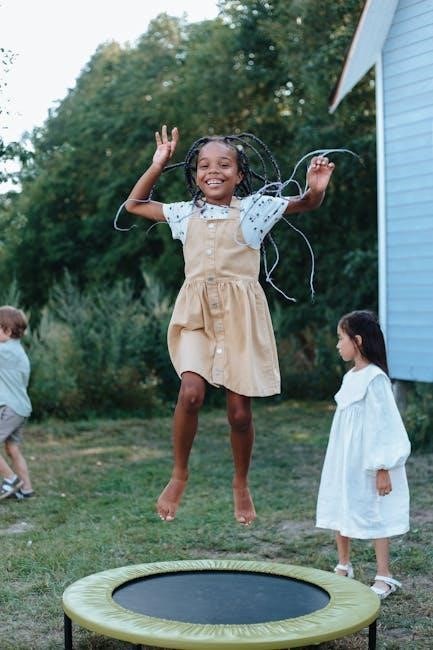Trampolines bring endless joy to families‚ but choosing the right size is crucial for safety and fun. This guide helps you select the perfect trampoline size for your needs‚ ensuring years of bouncing enjoyment for kids and adults alike. Whether for recreation or fitness‚ the right size ensures safety and maximum fun. Let’s explore the world of trampoline sizes and find the ideal fit for your family!
1.1 Understanding the Importance of Size Selection
Selecting the right trampoline size is vital for safety‚ functionality‚ and user enjoyment. The size determines the jumping area‚ bounce quality‚ and suitability for users. A trampoline that’s too small may limit fun‚ while one too large might not fit your yard or budget. Proper size selection ensures safe use‚ optimizes space‚ and meets the needs of all users‚ whether for recreational play or athletic training. Choosing the right size enhances safety‚ comfort‚ and long-term satisfaction for the whole family.

Factors to Consider When Choosing a Trampoline Size
When selecting a trampoline size‚ consider user age‚ weight‚ available space‚ intended use‚ and budget. These factors ensure a safe and enjoyable experience for everyone involved.
2.1 Age and Weight of Users
The age and weight of users are critical factors in choosing the right trampoline size. Smaller trampolines (6-8 ft) are ideal for young children‚ while larger ones (14-15 ft) accommodate older kids and adults. Weight limits vary‚ so ensure the trampoline can support the combined weight of all users. For families with multiple children‚ a medium or large trampoline offers ample space for safe and enjoyable bouncing. Always check the manufacturer’s weight capacity to ensure safety and durability.
2.2 Available Space and Yard Layout
Measure your backyard carefully to ensure the trampoline fits comfortably. Consider obstacles like trees‚ slopes‚ and fences. Leave at least 6 feet of clearance around the trampoline for safety. The yard layout should allow easy access and supervision. A larger trampoline may require a more open space‚ while smaller ones can fit into tighter areas. Ensure the area is flat and even to prevent tipping. Proper placement ensures safe and enjoyable use for everyone.
2.3 Intended Use (Recreational vs. Athletic)
The intended use of your trampoline plays a significant role in size selection. For recreational purposes‚ smaller sizes (8-10 ft) are ideal for casual bouncing and family fun. However‚ for athletic training or high-energy activities‚ larger trampolines (12 ft and above) are recommended‚ as they provide more space and a higher bounce. Consider the primary use to ensure the trampoline meets your needs and supports safe‚ enjoyable experiences for all users.
Common Trampoline Sizes
Trampolines come in various sizes‚ from small 6-8 ft models for kids to large 14-15 ft options for families and extra-large 16 ft+ for athletes.
3.1 Small Trampolines (6-8 ft)
Small trampolines‚ measuring 6-8 feet in diameter‚ are ideal for young children or single users. They are perfect for small yards or limited spaces‚ providing a safe and fun way for kids to bounce. These trampolines are lightweight‚ easy to assemble‚ and often come with safety enclosures to prevent falls. They are great for introducing toddlers to trampolines or for families with smaller backyards. Maintenance is straightforward‚ and they offer excellent value for casual‚ recreational use while ensuring safety for little ones.
3.2 Medium Trampolines (10-12 ft)
Medium trampolines‚ ranging from 10 to 12 feet in diameter‚ are a popular choice for small to medium-sized families. They offer ample jumping space for multiple children while fitting neatly into average-sized yards. These trampolines are sturdy‚ providing a good bounce for both kids and adults. Safety features like enclosures and padding are often included‚ making them a practical option for active families. Measuring your yard beforehand ensures a perfect fit‚ balancing fun and safety for years of enjoyment. They are ideal for families with several children who want to bounce together.
3.3 Large Trampolines (14-15 ft)
Large trampolines‚ measuring 14 to 15 feet in diameter‚ are ideal for bigger families or those who enjoy energetic bouncing sessions. These trampolines provide ample space for multiple jumpers and are sturdy enough to handle higher weight capacities. They are perfect for active families or serious enthusiasts‚ offering a superior bounce and durability. While they require more space‚ their robust frames and safety enclosures ensure safe and enjoyable use for years to come‚ making them a worthwhile investment for larger households or frequent users.
3;4 Extra-Large Trampolines (16 ft and Above)
Extra-large trampolines‚ starting at 16 feet and beyond‚ are designed for maximum space and performance. These expansive models are perfect for large families‚ athletic training‚ or commercial use. They offer an exceptional bouncing experience with high weight limits‚ making them ideal for multiple users. However‚ they require significant yard space and a substantial budget. Despite the higher cost‚ these trampolines provide unparalleled durability and versatility‚ catering to both recreational and professional needs with their robust construction and extensive features.
Safety Considerations
Safety is paramount when selecting a trampoline. Ensure the model includes a sturdy enclosure‚ adequate padding‚ and durable springs. Regular maintenance and proper supervision are essential to prevent accidents and injuries‚ while adherence to weight limits guarantees safe use for all users.
4.1 Safety Features to Look For
When selecting a trampoline‚ prioritize safety features such as a sturdy enclosure net‚ thick padding covering springs‚ and a durable frame. Ensure the enclosure is securely attached to prevent users from falling off. Look for models with spring padding that extends beyond the mat for added protection. Durable materials and a weight capacity that matches your family’s needs are also crucial. Additionally‚ consider UV-resistant components to ensure longevity and safety under sunlight exposure. Always check for certifications from reputable organizations to guarantee adherence to safety standards.
4.2 Recommended Safety Clearances
For optimal safety‚ ensure your trampoline has adequate clearance from obstacles. Maintain at least 24 feet of overhead clearance to avoid branches or power lines. Surround the trampoline with 6 feet of open space on all sides to prevent collisions with fences or structures. Additionally‚ keep the area around the trampoline free from hazards like rocks or toys. Proper clearance ensures jumpers can move safely and reduces the risk of accidents. Always consider supervision and accessibility when positioning your trampoline in the yard.

Measuring Your Backyard
Measure your yard to ensure the trampoline fits securely. Use a tape measure to check both ground space and overhead clearance‚ ensuring proper fit and safety.
5.1 How to Measure Your Yard for the Best Fit
Accurately measure your yard to ensure the trampoline fits perfectly. Use a tape measure to determine the width‚ length‚ and overhead clearance. Clear obstacles and consider surrounding structures. Leave at least 6 feet of space around the trampoline for safety. Check for power lines‚ trees‚ or slopes that might interfere. Measure multiple areas if your yard is uneven. Ensure the trampoline is placed on level ground for stability. This careful planning ensures a safe and enjoyable bouncing experience for everyone.
Choosing the Right Size for Your Family
Assess the number of users and their activity levels to pick the ideal trampoline size. Larger families or energetic jumpers benefit from bigger sizes for optimal fun and safety.
6.1 Number of Users and Activity Level
The number of users and their activity level significantly impact the trampoline size choice. Families with multiple children or high-energy jumpers should opt for larger sizes to ensure ample space and safety. A trampoline that accommodates everyone comfortably prevents overcrowding‚ reducing the risk of accidents. Consider the age and weight of users‚ as larger trampolines provide better support and bounce for heavier or more active individuals. This ensures a fun and safe experience for all.
Technical Specifications
Trampoline technical specs include spring size‚ frame thickness‚ and padding quality. These details ensure durability‚ safety‚ and optimal performance‚ making them crucial for informed purchasing decisions.
7.1 Spring and Frame Size Considerations
Spring and frame size significantly impact a trampoline’s performance. Larger springs provide a higher bounce‚ while sturdier frames ensure stability. Measure springs from hook to hook and ensure frames are durable. Thicker frames and high-quality springs enhance safety and longevity. Proper spring tension and frame alignment are vital for optimal functionality. Always check these specifications to match your needs for both recreational and athletic use.

Maintenance Tips
Regularly inspect springs and frames for damage. Remove ladder after use to prevent unsupervised access. Use a spring scale to maintain bounce quality and safety. Clean and tighten parts as needed for optimal performance and longevity. Always follow manufacturer guidelines for care and repairs.
8.1 Keeping Your Trampoline in Prime Condition
Regular inspections are key to maintaining your trampoline. Check springs and frames for damage or wear. Use a spring scale to ensure optimal bounce and safety. Remove the ladder after use to prevent unsupervised access. Clean the mat and frame regularly‚ and tighten loose parts. Store the trampoline in winter to protect it from harsh weather. Replace worn-out components promptly to ensure longevity. Follow manufacturer guidelines for repairs and maintenance to keep your trampoline safe and durable for years of enjoyment.

Budget Considerations
Trampoline prices vary based on size‚ features‚ and quality. Larger trampolines cost more but offer better durability. Compare models to find the best value within your budget.
9.1 Cost Implications of Different Sizes
Trampoline prices increase with size and features. Small trampolines (6-8 ft) are affordable‚ costing $100-$300‚ while medium (10-12 ft) range from $300-$600. Large trampolines (14-15 ft) cost $600-$1‚000‚ and extra-large models (16 ft+) can exceed $1‚200. Additional features like enclosures‚ springs‚ and padding add to the cost. Budget accordingly‚ balancing size‚ safety‚ and durability to ensure long-term value and family enjoyment.
Selecting the right trampoline size ensures safety‚ fun‚ and lasting enjoyment. Consider your space‚ users‚ and budget to make an informed decision for years of bouncing joy!
10.1 Final Thoughts on Selecting the Perfect Trampoline Size
Choosing the ideal trampoline size involves balancing space‚ safety‚ and user needs. Measure your yard‚ consider the age and weight of jumpers‚ and prioritize safety features. While larger trampolines offer more bouncing area‚ smaller ones may better suit limited spaces. Budget considerations are also key‚ as sizes impact costs. By weighing these factors‚ you can select a trampoline that brings endless fun and safety to your family for years to come. Happy bouncing!



